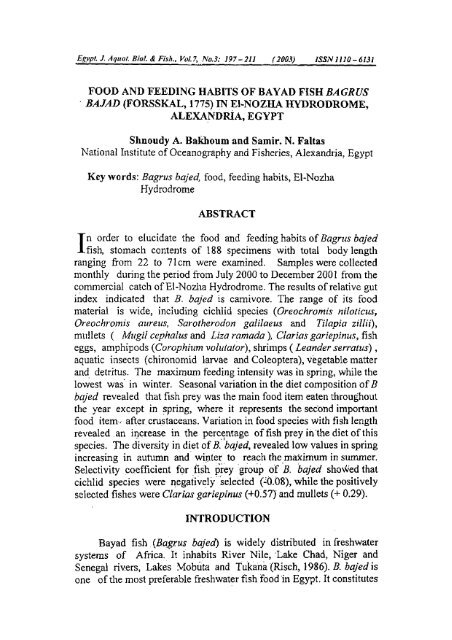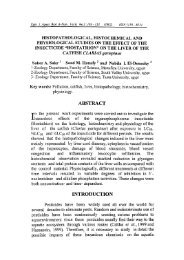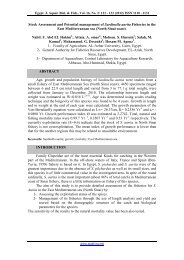FOOD AND FEEDING HABITS OF BAY AD FISH BAGRUS BAJAD ...
FOOD AND FEEDING HABITS OF BAY AD FISH BAGRUS BAJAD ...
FOOD AND FEEDING HABITS OF BAY AD FISH BAGRUS BAJAD ...
- No tags were found...
Create successful ePaper yourself
Turn your PDF publications into a flip-book with our unique Google optimized e-Paper software.
198 Shnoudy A. Bakhoum and Samir. N. Faltasabout 1.5% ofthe total fish production of Egypt (GAFRD, 2000). Alsoit constituted a nearly similar percentage in the catch of NozhaHydrodrome (1.34%). The study of diets and food habits of fish andother marine invertebrates through the examination of stomachcontents has become a standard practice (Hyslop, 1980). In addition,knowledge ofthe feeding habits is an important way to understand themechanism and processes, which structure fish assemblages (Kotrshaland Thomson, 1986). The purpose of this study is to provide detailedinformation on the feeding habits of this species as well as itsvariations according to season and fish size. Also to elucidate theeffect of the feeding habits of B. bajed on the other fish speciesinhabiting the same area, which play an important role in speciescomposition ofthe catch in El-Nozha Hydrodrome.MATERIALS <strong>AND</strong> METHODSSamples of Bagrus bajed were collected monthly during theperiod from July 2000 to December 2001 by Seine nets fromcommercial catch of El-Nozha Hydrodrome. It is an isolated part ofLake Mariut lying in its northeastern side at latitude 31° 10 Eandlongitude 30° R It has a total area of about 504 hectares, while itsdepth ranges between 3.4 and 3.8 meters below the mean sea level, andthe average water depth is about 2.7 meters (Gharib, 1991). A total of188 fish ranging from 22 to 71cm total body length were examinedwithin the frame of the scientific program for environmental andfishery investigations of El-Nozha Hydrodrome near Alexandria. Foreach specimen, total and standard lengths (cm), total and guttedweights (g) were recorded. Then, stomachs were preserved in 10 %formalin solution. Weights of food contents (g) were determined andanalysed to the lowest possible taxon or category depending on thedigestion stage of each item. Number and weight ofthe different preyin each stomach were taken. The intestine length was measured to thenearest 0.1 cm for computing the relative gut index (RGI). Emptycoefficient (percentage of the empty stomachs to the total number ofstomachs examined) and fullness index (percentage ofthe weight ofstomach contents to the gutted body weight ofthe fish) were used todetermine seasonal differences in feeding intensity for mentionedspecies- The contribution of each type of food to the diet wasexpressed as percentage frequency of occurrence (%0), numericalpercentage (%N) and weight percentage (%W). The percentage index
<strong>FOOD</strong> <strong>AND</strong> <strong>FEEDING</strong> <strong>HABITS</strong> 199<strong>OF</strong> <strong>BAGRUS</strong> SAJ<strong>AD</strong> IN ALEX<strong>AND</strong>RIA, EGYPTof relative importance (% IRI) after King (1984) and Cortes et al(1996) was used. This index combines prey number, weight andoccurrence as described by Hyslop, (1980). Seasonal variations infullness index were analyzed using the one-way ANOVA test(Snedecor and Cochran, 1980). Contingency table analysis was appliedfor testing the seasonal variation in diet composition of B, hajed andabundance by number of the food categories at different size groups(Crow, 1982). The seasonal variations in diversity of food weredetermined by using the index of Shannon and Weaver, (1963),Determining selectivity coefficient was carried out after Ivlev (1961),to assess the selectivity of B. bajed to each fish prey.RESULTSRelative gut indexThe relative gut index (RGI) of Bagrus bajed was in the rangefrom 0.8 to 1.0 (mean ± standard deviation = 0.92+ 0.090) for fish of18-55 cm standard length. These results indicate that B. bajed iscarnivore.Feeding intensitySeasonal variations of empty coefficient (E. C.) indicated thatlowest values of empty stomachs were found in autumn (39.02%) andincreased to 48.94% in spring, while the highest percentages of emptystomachs (61.00% and 62.50%) were observed in summer and winterrespectively. Fullness index (F.I) revealed that the highest degrees ofstomach fullness were in spring (0.98) and autumn (0.59) while thelowest ones was recorded in winter (0.41) and summer (0.43), OnewayANOVA test indicated significant seasonal difference in fullnessindex of B. bajed (F=3.492 3 df=3.p
<strong>FOOD</strong> <strong>AND</strong> <strong>FEEDING</strong> <strong>HABITS</strong> 201<strong>OF</strong> <strong>BAGRUS</strong> BAJ<strong>AD</strong> IN ALEX<strong>AND</strong>RIA, EGYPTfood category in autumn (%0 =12 and %W= 3%) and disappeared inthe diet of this species in the summer (Table 2). Contingency tableanalysis was applied for testing the seasonal variation in dietcomposition of B. Bajed. It showed highly significant difference in theprey composition among seasons (G=l 88.763, p
202 Shnoudy A. Bakhoum and Samir. N. Faltashigh followed by aquatic insects and crustaceans. According toHickley and Bailey (1987), B. bajed is described as macro-predator inRiver Nile (southern Sudan), its diet consists mainly of fish prey,aquatic insects, organic detritus and aquatic higher plants.The seasonality associated with feeding in the present studyindicated that the maximum degree of feeding intensity was in spring,while the lowest one was in winter. The seasonal variations in feedingintensity may be attributed to the spawning activities, where thephysical space in the body cavity available for the stomach at thespawning period was small, beside the effect of optimum temperatureon metabolic rate or food availability (Kuo and Tanaka, 1984;Nwadiaro and Okorie, 1987). Khallaf et ah (1991) reported that B.bajed is multiple spawner as an environmental adaptation to ensurefavourable conditions for the offspring. This finding excludes the roleof reproductive activities on feeding intensity. However, The declinedfeeding intensity in winter during the present study agrees with thatreported by Hashem (1981).Seasonal variations in diet composition of B. bajed revealedthat fish prey was the main food item eaten through the whole yearexcept in spring, which represents the second important food item aftercrustaceans. This finding accords with Hashem (1981), who showedthat crustaceans appeared most frequently and represented moreabundant food items during spring, while the fish prey was observed ina high percentage during winter months in the fish diet. The seasonalvariability in the diet composition of this species corresponds to theabundance of these food items in the habitat, which appeared to beinfluenced by water temperature and other environmental conditions.This agrees with Gharib, (!991) who stated that flourishing ofcrustaceans in El-Nozha Hydrodrome occurred in spring.Variation in abundance of food species with fish size for Bagrusbajed indicated that the increase in the length range resulted anincrease in the percentage offish prey in the diet of this species. Thiscoincided well with the finding of Bishai (1970) for B. bajed in Sudanand Hashem (1981) on the same species in Nozha Hydrodrome.The diversity in the diet of 5. bajed, which comprised low valuesin spring increasing in autumn and winter to reach the maximum valuein summer may by attributed to the wide spectrum of food items insummer in the habitat.Computed selectivity coefficient of the fish prey groups in thestomach contents of B. bajed showed that Clarias .gariepinus and
<strong>FOOD</strong> <strong>AND</strong> <strong>FEEDING</strong> <strong>HABITS</strong> 203<strong>OF</strong> <strong>BAGRUS</strong>BAJ<strong>AD</strong> IN ALEX<strong>AND</strong>RIA, EGYPTmullets were positively selected, while cichlid species were notprefered food items for this species. The preference ability of B. bajedto these species plays an important role in species composition of thecatch in the examined area. Factors that influence food selectivity ofpredators are the size and morphology of the food organisms (Bentzenand McPhaii, 1984).ACKNOWLEDGEMENTThe authors wish to express their sincere thanks to Prof. Dr A.Alsayes head of fishery branch, N.LO.F., for his support and valuableadvice. Also they extend their gratitude to all the scientific staff of theprogram for environmental and fishery investigations of the El-NozhaHydrodrome near Alexandria, for their kind help in collecting thepresent material.REFERENCESBentzen, D. and McPhaii, J. D. (1984). Ecology and evolution ofsympatric sticklebacks (Gasterosteus): specialization foralternative trophic niches in the Enos Lake species pair.,Can. J.'Zool., 62: 2280-2286.Bishai, R. M. (1970). Studies on the biology of family Bagrid(pisces) in the Sudan. Ph. D. Thesis, Fac. Sci M Cairo Univ.Cortes, E. ; Manire, C. A. and Heuter, R. E. (1996). Diet, feedinghabits, and diet chronology of the bonnethead shark,Sphyrna tiburo: in southwest Florida, Bull., Mar. StiL, 58(2): 353-367.Crow, M.E. (1982). Some statistical techniques for analysing thestomach contents of fish .In fish food habits studies.Proceedings of the 3 rd Pacific Northwest' technicalworkshop G. M. Cailliet and.. G.. ; A>. Simensted(eds).Washington Sea Grant publication. Washington univ.Seattle, Wash: pp.8-15.GAFRD, (-2000). General Authority for fish resources development,data on fish Production in Egypt, Ministry of Agriculture.Cairo., 207pp.
204 Shnoudy A. Bakhoum and Samir. N> FaltasGharib, S. M. (1991). Study of the biological productivity of the EI-Nozha Hydrodrome as a model of artificially fertilized fishfarm. Ph.D. Thesis, Fac. Sci., Mansoura Univ., 453pp.Hashem, M. T. (1981). The feeding and Fatness of Bagrus bajad.Bull. Inst. Oceanogr. & Fish., 7(3) :442-454.Hickley, P. and Bailey, R. G. (1987). Food and feeding relationshipsof fish in the Sudd swamps (River Nile, southern Sudan). J.Fish BioL, 30: 147-159.Hyslop, E. J. (1980). Stomach contents analysis, a review ofmethods and their application. J. Fish. BioL, 17: 411-430.Ivlev, V. S. (1961), Experimental ecology of the feeding offish. YaleUniv. press, New Haven, Conn. 302pp.Khallaf, E. A. ; El-Saadany, M. M. and Authman, M. N. (1991).Oogenesis of Bagrus bajed, Forskaal.(Bagridae, Teleostei).J. Egypt. Ger. Soc. ZooL, 5:1-14.King, K. 1 (1984). The food of rig (Mustetus lenticulatus ) and therelationship of feeding to reproduction and condition inGolden Bay. New Zeal. J. Mar. Freshw. Res., 75: 27-43.Kotrshal, K. and Thomson, D. A. (1986). Feeding patterns in easterntropical Pacific blennioid fishes (Teleostei: Triptrygiidae,Labrisomidae, Chaenopsidae and Blennidae). Oecologia, 70:367-378.Kuo, C. and Tanaka, S. (1984). Feeding habit of YLoki Macruronusnovaezelandidae (Hector) in water around New Zealand.Bull. Japanese Soci. Scien. Fish., 50(5): 783-786.Nwadiaro, C. and Okorie, P. (1987). Feeding habits of the AfricanBagrid, Chrysichtkys filamentosus in a Nigerian Lake.Japanese J. Ichth. 55(4): 376- 382.
<strong>FOOD</strong> <strong>AND</strong> <strong>FEEDING</strong> <strong>HABITS</strong> 205<strong>OF</strong> <strong>BAGRUS</strong> BAJ<strong>AD</strong> IN ALEX<strong>AND</strong>RIA, EGYPTOdum, W. E. (1968). The ecological significance of fine particleselection by the striped mullet Mugil cephalus. Limnol.Oceeanogr., 13: 92-98.Risch ? L. M. (986).Bagridae: in Check-List of the freshwater fishesof Africa. Daget, J. ; Gosse, J. P. and D. F. E. Thys vandenAudenaerde (eds.). ISNB, Brussels; MRAC, Tervuren;and ORSTOM, Paris., 2: 2-35.Shannon, C. E. and Weaver, W. (1963). The mathematical theory ofcommunication. Urana Univ. Press, Illinois.Snedecor, G: W. and Cochranw, W. G. (1980) , Statistical methods.Ames, pp. 39-63. Iowa: The Iowa state University Pres^
Table (1): Diet composition ofBagrus bajad in EI-Nozha I lydrodrome. %0 frequency of occurrence,°A 'a N= numerical percentage, %W= weight percentage and % IRI = percentage of relative importance index.%IRI jTcleosts 63.51 9.1 83.98 58.83Cichlid species 25 4.69 54.88 4084Mullets 8.78 1.5G 14.88 3.96Clarias gariepinus 0.68 0.0,9 2.51 0.05Fish eggs 0.68 2.76 0.02 0.05Unidentified fish remains 34.46 11.69Crustaceans 42.57 90.52 6.68 41.18Amphipods 18.92 77.09 2.27 41.18Shrimps 28.38 13.43 4.41 13.89 !Aquatic insects 2.03 0.37 0.17 0.03Vegetable matter 0.68 0.05Detritus 0.68 0.04Digested food 20.27 9.09iOO03©cBBa.&BFood items %0 %N %Wor0o
<strong>FOOD</strong> <strong>AND</strong> <strong>FEEDING</strong> <strong>HABITS</strong> 207<strong>OF</strong> <strong>BAGRUS</strong> BAJ<strong>AD</strong> IN ALEX<strong>AND</strong>RIA, EGYPTCMCOto 18od8dLf)COdCOCOCMCO3 §o>8dCOoododCOodCOCOoaCOCOCMoad d§d CM£ ^5COoCOCOm odod COa>V"coiCOCOaodCM3 COCOCMododOCMCMCO3 dCMCOs 8doIV.oCMCMCO^—COCMCOCOinTdOOdCMCMCOCOCOtoCOCOCDdCOOd35WCOCDCMo 8dojCO (0CMenCOd■oodCMcnCMCOoCOCOCOoCOaaodenendenCOO)pioCOCOdEtriCOCOCOCMCOCOdCOtoCModoodtoCO3totomoCMino> ■torMCNCMOod8 8o dK 5i S 8 8 t « 8 ?8 8 8 8d oCOcocn T8 » S 8 8 8g cd N: d dfc ^ dwCO v-cn CD CO8 8 CO COCO or^CM CM 8 8 «d £ d d 1^d CO r^ d dd 5CMCMCO8 8 8 9 CM8 CO■8os CM CO' d d9' cnCO CM8 CO DCO1 ^CM CM CDs CM CM 8 8 oXMc* T- T~ d ds> 8 t^ •du&wU
Table (3): Variations in diet composition of food species by number with total length groups orBagrus bajad in El- Nozha Hydrodrome.Teleosts 6.37 4.95 16.39 52.94 68.43Cichlid species 5.73 3.3 4.44 52.94 42.11Mullet 0.64 1.48 1.71 0.00 26.32Ciarias spp 0.00 0.17 0.00 0.00 0.00Fish eggs 0.00 0.00 10.24 0.00 0.00Crustaceans 93.63 94.4 83.62 47.06 31.58Amphipods 80.89 79.24 77.13 23.53 0.00Shrimps 12.74 15.16 6.49 23.53 31.58Aquatic insects 0.00 0.66 0.00 0,00 0.00Length groups ( sm.)Food items 60
<strong>FOOD</strong> <strong>AND</strong> <strong>FEEDING</strong> <strong>HABITS</strong><strong>OF</strong> <strong>BAGRUS</strong> BAJ<strong>AD</strong> IN ALEX<strong>AND</strong>RIA, EGYPTCO0>oCDCD-CO~o *4-»c~
toomm0O0CO's!2J0B1.41.21■ Diversity« 0.8to01g 0.6 ^0.40.20Spring Summer Autumn WinterSeasons—iFig.2. Seasonal variations in diversity index of Bugrus bayad from EI-NozhaHydrodrom.
















